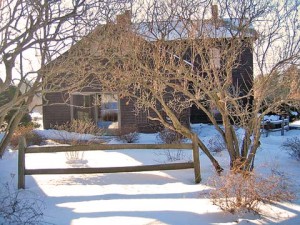Exposing the Bones
The Garden's Skeleton
How did you conceive the spatial layout of your garden? Perhaps you planted a row of shrubs to outline a path, and a group of trees to set off the house. Maybe you thought in terms of separate garden spaces...a patio, a flower and/or vegetable garden and a a play space? And possibly you also positioned two of these spaces along an invisible axis. This overall spatial composition creates the garden's underlying structure.
And since this composition, however relaxed and informal, acts a bit like a skeleton, visually holding everything together, it is often dubbed the 'bones of the garden'.
Winter shows off your garden's bones
And in winter, with leaves and flowers no longer clothing the garden, we become more attuned to its underlying skeleton. So in creating a design for the winter garden it helps make that skeleton or composition more readily apparent... and we call this ‘exposing the bones’.
Lorraine and Warren Kimble's garden in Brandon, Vermont

Lorraine and Warren Kimble's garden in Brandon, Vermont
Two different areas of an earlier garden of Lorraine and Warren Kimble in Brandon, VT illustrate how the bones can indeed make a strong statement in winter.
A rustic stone path, echoed by the split-rail fence running along its left side, creates a pointer to the cluster of brown-stained country buildings.

Lorraine and Warren Kimble's garden, Brandon, Vermont
While in summer this axis is gently apparet, it is really stands out after the flowers are gone.
Later in winter the snow may deeper... and then, yes, the path will disappear... But the fence will remain, still keeping the eye pointed toward the barns.
.

A split rail fence and old lilacs in the Kimble garden
In another corner of this same garden a single section of a split rail fence deftly separates two garden spaces.
In summer the fence is totally hidden by the profusion of perennials, but in winter it comes into its own as a strategic part of the design.
.
.
Blending formal and informal
I originally conceived our back garden as a combination of linear and curvaceous:
The garden's two key elements... a circular patio and a square-shaped gazebo...would be positioned on an imaginary axis, set at 45° diagonal to the house.
Gently curving flowerbeds would tie into to the natural undulations and boundaries of the land.
I had previously laid in a long curvaceous perennial bed, with its back edge paralleling the hedgerow along the road. Then, in the winter of 1997, I worked up a scale drawing of a more complete design and the dimensions of the two items we would be having built for us...the patio and the gazebo...as well as for the fluid shapes of the flower beds that over time we would be adding ourselves.
Over the years we gradually implemented the garden, and at each step along the way the drawing served as the blueprint:
In the spring of 1997 two stonemasons built the 22-feet diameter field-stone patio. But before they started work, I established the exact spot for its center to correspond with my drawing.
In the summer of 2000 a carpenter-friend collaborated with us on the detailed design of the gazebo. But before actual construction began, he and I set up a string along my imaginary axis, and used it to establish both the center point of the gazebo and its orientation (at exactly 90° to the axis).
A few years later he returned to build an arbor at the entrance to the patio, and at right angles to the axis.
And, as the years rolled along, we both added new garden beds and expanded existing ones. Again the original drawing acted as the guide for the placement and the shapes of these, definitely non-linear, beds.

See in this picture how an imaginary line links the centers of the gazebo, arbor and patio.
Like clothes on a great body, in summer the flowers get all the attention.
And certainly in summer, with my attention going to the flowers, I must admit that I don't give the garden's skeleton a second thought.
But in the starkness of winter it is the skeleton that makes the picture.